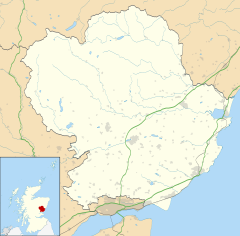Barry, Angus
| Barry | |
|---|---|
| Barry shown within Angus | |
| OS grid reference | NO536344 |
| • Edinburgh | 42 mi (68 km) SSW |
| • London | 367 mi (591 km) SSE |
| Council area | |
| Lieutenancy area | |
| Country | Scotland |
| Sovereign state | United Kingdom |
| Post town | CARNOUSTIE |
| Postcode district | DD7 |
| Dialling code | 01241 |
| Police | Scottish |
| Fire | Scottish |
| Ambulance | Scottish |
| EU Parliament | Scotland |
| UK Parliament | |
| Scottish Parliament | |
Barry is a small village in Angus, Scotland on Barry Burn at the mouth of the River Tay. The recent completion of a bypass for the village on the A930 road from Dundee to Carnoustie is something that was originally planned before the Second World War. There is a water mill (Barry Mill) operated by the National Trust for Scotland. The village is served by Barry Links railway station. The village was formerly served by Barry primary school which closed in 2007.
The Parish of Barry, which was originally known as Fethmoreth, Fethmure, Fettermore or Fethmuref was originally bestowed to the monks of Balmerino Abbey in Fife by Alexander II in 1230. An early record of it can be found in a proverb attributed to Thomas the Rhymer:
The monks originally managed the lands from the Grange of Barry and latterly the land was controlled by the office of the Bailies of Barry, an early holder of this position being Sir Thomas Maule of Panmure in 1511.
A number of feus were granted in the Parish around that time, including Ravensby in 1539, Gedhall to David Gardyne in 1541, half of Barry Links and Cowbyres to Walter Cant in 1545 and the other half of the links to Robert Forrester in 1552.
The land was annexed by the crown in the Protestant reformation following an Act of Parliament in 1587 and the Bailiery of Barry was granted by James VI as a heritable gift to Patrick Maule in 1590. Ownership of the lands was granted by the King to James Elphinstone, Secretary of State in 1599 (ratified 1605), and was sold to George Maule, 2nd Earl of Panmure in 1667 (ratified in 1672) for £746 13s 4d. The land was forfeited following James Maule, 4th Earl of Panmure's involvement in the Jacobite Rebellion in 1715.
...
Wikipedia

